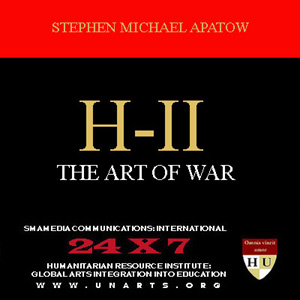
Website: http://www.unarts.org/H-II
Human Trafficking is the "'...recruitment, transportation, transfer, harbouring or receipt of persons...' by improper means, such as force, abduction, fraud, or coercion, for an improper purpose, such as forced or coerced labour, servitude, slavery or sexual exploitation." -- UN Protocol to Prevent, Suppress and Punish Trafficking in Persons. (1)
The H-II UN International Legal/Human Rights Focus is Human Trafficking of Children and Adults (2), the intervention encompasses an intensive coordinated global law enforcement incursion and relief initiative that includes:
* prosecution of criminals responsible for associated crimes.
* sheltering, medical care and rehabilitation for children and adult victims.
According to the "Training manual to fight trafficking in children for labour, sexual and other forms of exploitation" (ILO, UNICEF and the Global Initiative to Fight Human Trafficking) (3):
* UNICEF estimates that 1,000 to 1,500 Guatemalan babies and children are trafficked each year for adoption by couples in North America and Europe.
* Girls as young as 13 (mainly from Asia and Eastern Europe) are trafficked as “mail-order brides.” In most cases these girls and women are powerless and isolated and at great risk of violence.
* Large numbers of children are being trafficked in West and Central Africa, mainly for domestic work but also for sexual exploitation and to work in shops or on farms. Nearly 90 per cent of these trafficked domestic workers are girls.
* Children from Togo, Mali, Burkina Faso and Ghana are trafficked to Nigeria, Ivory Coast, Cameroon and Gabon. Children are trafficked both in and out of Benin and Nigeria. Some children are sent as far away as the Middle East and Europe.
* Surveys indicate that 30 to 35 per cent of all sex workers in the Mekong sub-region of Southeast Asia are between 12 and 17 years of age.
* Mexico’s social service agency reports that there are more than 16,000 children engaged in prostitution, with tourist destinations being among those areas with the highest number.
* In Lithuania, 20 to 50 percent of prostitutes are believed to be minors. Children as young as age 11 are known to work as prostitutes. Children from children’s homes, some 10 to 12 years old, have been used to make pornographic movies.
Interpol estimates have placed human trafficking and illicit migration as a USD 28 billion enterprise, a crime that amounts to modern slavery, requiring a multitude of strategies at a range of levels to address the problem. Trafficking in human beings (THB) takes many forms, five of which are briefly covered below (4):
* Trafficking in women for sexual exploitation
* People smuggling
* Child sexual exploitation
* Trafficking for forced labour/servitude
* Trafficking in organs
Listen to the Victims
After the collapse of communism in 1989, millions of former Soviet bloc residents migrated abroad, breathing life into one of the oldest criminal enterprises—the trafficking of humans into sexual slavery. Since then, thousands of Eastern European women have been sold into prostitution. Photojournalist Mimi Chakarova investigates this rarely documented journey. -- The Price of Sex: Women Speak: Center for Investigative Journalism. (5)
Listen to the victims Jenea, Aurica, Corina, Olesea, an overview of Women at Risk and Sex Trafficking: How It Works:
www.priceofsex.org
UNArts: Humanitarian Intervention Initiative (H-II)
Protective Forces in Humanitarian Relief Operations, Non Lethal Fires, and Intervention Initiatives are the focus of the UNArts: Humanitarian Intervention Initiative (H-II) (6). The objectives are to increase exposure, strategic planning, development and implementation of relief efforts for the world's most complicated emergencies.
Country Music Association Artist Stephen Michael Apatow, (7) founder of Humanitarian Resource Institute and the United Nations Arts Initiative is currently expanding collaboration and collecting video footage of humanitarian interventions from DOD/NATO, United Nations, Relief Organizations and NGO's working in UN member countries.
References:
1. International Human Trafficking Research: U.S. Department of Justice: National Institute of Justice. Url: http://www.ojp.usdoj.gov/nij/international/programs/inttraffick.html
2. International Bar Association Human Rights Institute: Url: http://www.ibanet.org/IBAHRI.aspx
3. Training manual to fight trafficking in children for labour, sexual and other forms of exploitation: ILO, UNICEF and the Global Initiative to Fight Human Trafficking. Url: http://www.unicef.org/protection/index_exploitation.html
4. Trafficking in human beings: Interpol. Url: http://www.interpol.int/Public/THB/default.asp
5. The Price of Sex: Women Speak: Center for Investigative Journalism. Url: http://www.priceofsex.org
6. Humanitarian Intervention Initiative (H-II): Humanitarian Resource Institute, United Nations Arts Initiative. Url: http://www.unarts.org/H-II
7. Stephen Michael Apatow, Founder of Humanitarian Resource Institute and the United Nations Arts Initiative. Url: http://www.apatow.org




No comments:
Post a Comment